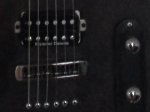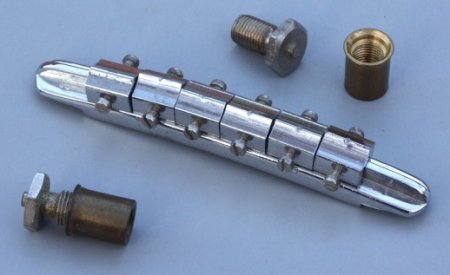You are using an out of date browser. It may not display this or other websites correctly.
You should upgrade or use an alternative browser.
You should upgrade or use an alternative browser.
roller bridges
- Thread starter notCardio
- Start date
JDOD
therecordingrebels.com
I have a roller bridge and its very nice indeed.
Its handy 'cos its through body strung so I have quite a steep break angle behind the bridge. The one I have provides lots of options for moving back and forth, side to side and up and down so I can really get detailed on the intonation.
I had some set up work done by the guy that built it a few days ago and I've been checking intonation all over the fretboard, its really impressive.

Its handy 'cos its through body strung so I have quite a steep break angle behind the bridge. The one I have provides lots of options for moving back and forth, side to side and up and down so I can really get detailed on the intonation.
I had some set up work done by the guy that built it a few days ago and I've been checking intonation all over the fretboard, its really impressive.

jimistone
long standing member
I just got one. I'm going to install it on a lap steel that I'm also installing string benders on. I'm also making a roller nut for it. I honestly can't see the benefit of a roller nut or roller bridge if you are not moving the string back and forth with a , whammy, or bender.
miroslav
Cosmic Cowboy
Yay or nay?
If you don't have a whammy bar, is there really any benefit?
It might actually be worse for you, depending on how you play and the guitar.
If you bend a lot, with a roller bridge, the sting can ride up/down in the roller...and if the break angle from the bridge to string anchor point is shallow, it could rob some sustain from your tone.
It could work OK for you, but it may also be a waste. I think people use them to remedy string breakage or something (which can be solved other ways)...otherwise, I don't see nay reall benefit to a roller bridge on a non-trem guitar.
ashcat_lt
Well-known member
The only roller bridge I have is on a baritone jaguar/jazzmaster clone thing with the floating trem, and it has that old problem where the low string pops out of the saddle if I just breathe on it hard! One of these days I'll get around to shimming the neck a bit, but for now it's all just frustration. In fact, I've gone so far as to just pop it out of the saddle before I tune it up so I can at least play through the damn song.
I have graphite saddles on my LP Studio and I'm really happy with them. To be fair I also had the nut replaced with graphite and the whole thing set up at the same time, so I can't say for sure what did what, but I don't break as many strings or have as many issues with tuning anymore. It seemed to brighten things up just a touch and maybe add a little sustain. Like the guitar just kind of woke up a little bit. It still hurts like hell to play, but it sounds pretty cool. (...well it did before wiring went fucky. That's on "the list" also...)
I have graphite saddles on my LP Studio and I'm really happy with them. To be fair I also had the nut replaced with graphite and the whole thing set up at the same time, so I can't say for sure what did what, but I don't break as many strings or have as many issues with tuning anymore. It seemed to brighten things up just a touch and maybe add a little sustain. Like the guitar just kind of woke up a little bit. It still hurts like hell to play, but it sounds pretty cool. (...well it did before wiring went fucky. That's on "the list" also...)
Nola
Well-known member
Both my guitars have them, and I love them. One has a Bigsby and the other a Jazzmaster with that complex tremolo and a staytrem (amazing bridge). Another perk is they're the only bridges I've found for these guitars that are extremely smooth for palm muting, which is important to me. No sustain issues. If you raise the action you get a little more, but I keep it about 4/64ths and get sustain fine.
Nola
Well-known member
Yeah....but you're talking about a trem setup...where the roller bridge is needed.
For a non-trem guitar, there's really no benefit to using a roller bridge...other than it might feel better for your palm, but you then lose on the sustain/tone/bends side of things.
Hm, I've never had problems with sustain or bends. Before I replaced the JM bridge with a staytrem strings would pop out of the slots, but other than that no issues with bends. Bends do feel a little "tight" (not as responsive as say the Strat I owned), but I'm not sure if that's the bridge. I sold that strat because palm muting on it was hell. It would engaged the trem even with it pinned to the body, and those tall screws dig into the hand.
miroslav
Cosmic Cowboy
Like I said...it's how you play and the guitar setup...but the real point was that there is no benefit to using a roller bridge for a non-trem guitar, which is what the OP was asking.
I guess...if it feels more comfortable to your palm, might be considered a "benefit"...but I personally haven't found bridge comfort a problem.
Sometimes the last E string saddle seems to "dig in" the most, and I've simply taken a fine Emery board and given the edges a little buffing. Granted, it doesn't change the shape of the overall bridge, but it does take out the bite.
The sustain/tone/bend differences may be subtle, but I;ve seen enough people have the same opinion about using a roller bridge for non-trem guitars. I tried it once when I had an extra roller bridge, and it lasted for about a day of playing, and I went back to the fixed bridge. I just didn't like the way the strings would float around when bending. There wasn't that solid feel to it.
You may not be bothered by it.
I guess...if it feels more comfortable to your palm, might be considered a "benefit"...but I personally haven't found bridge comfort a problem.
Sometimes the last E string saddle seems to "dig in" the most, and I've simply taken a fine Emery board and given the edges a little buffing. Granted, it doesn't change the shape of the overall bridge, but it does take out the bite.
The sustain/tone/bend differences may be subtle, but I;ve seen enough people have the same opinion about using a roller bridge for non-trem guitars. I tried it once when I had an extra roller bridge, and it lasted for about a day of playing, and I went back to the fixed bridge. I just didn't like the way the strings would float around when bending. There wasn't that solid feel to it.
You may not be bothered by it.
When I bought my 355 -used, it had that 'gibson vibrato bar. That had to go. So I had a stop tailpiece set in. I also replaced the bridge at some point, using a roller type. I don't recall if the standard is normal tune-o-matic- I assume so?
But for me the reason for the roller bridge is I can set (or fine tune) the string width and placement.
Any who.. I've never had a problem with strings oping out.
So.. Yay
But for me the reason for the roller bridge is I can set (or fine tune) the string width and placement.
Any who.. I've never had a problem with strings oping out.
So.. Yay

ashcat_lt
Well-known member
I think I fixed that for you. (???)Any who.. I've never had a problem with strings popping out.
The typical TOM/stopbar setup gives a pretty sharp break angle and usually allows plenty of downward force to keep the strings in the saddles. JM/Jaguar-type guitars I think the saddle itself is a little closer to the body to begin with, and the anchor point of the strings is a lot further from there. It can be a real battle and balancing act to get that break angle tight enough to keep the strings from jumping ship.
Nola
Well-known member
JM/Jaguar-type guitars I think the saddle itself is a little closer to the body to begin with.
Yeah, it's the one design flaw with JMs (never owned a Jaguar so can't speak to it). I think they were originally strung with much higher gauge strings (12s), so it probably wasn't an issue, but once people wanted to use them for rock/bends, etc, that bridge became a problem. Break angle stinks on it. Even with the staytrem it's not great. It's probably smart to use 5/64ths and 11gauge on a JM, though I go 4/64 and 10 and deal with the slight trade offs. I love them. They're bright like strats yet not as ice picky/quacky.
miroslav
Cosmic Cowboy
...I can set (or fine tune) the string width and placement.
The ones I've seen/used are all set in one place by the manufacturing...no side-to-side adjustment, just back to front for intonation.
I have 4 vintage Hagstrom Swedes from the mid-'70s that are fixed bridge, but the bridge allows for side & front saddle adjustments.
Like this one:

The later stuff and the reissues all use the standard type of fixed, which only gives you front/back adjustment.
The rollers are on a screw-shaft, which makes them much narrower, = lots of width range.The ones I've seen/used are all set in one place by the manufacturing...no side-to-side adjustment, just back to front for intonation.
I have 4 vintage Hagstrom Swedes from the mid-'70s that are fixed bridge, but the bridge allows for side & front saddle adjustments.
Like this one:

The later stuff and the reissues all use the standard type of fixed, which only gives you front/back adjustment.
Just lift the string to adjust.
Might be this one
Schaller Roller Bridge | stewmac.com

